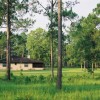 Wildfire is one of the most serious and publicized challenges facing interface forest management. Wildfires can change forest vegetation, affect human health, and cause millions of dollars’ worth of damage to homes, businesses, timber, and tourism. This 5-page fact sheet outlines tips for the firewise community development, design of structures, landscaping and fuel reduction. Written by Bruce Hull, Sarah F. Ashton, Rien M. Visser, and Martha C. Monroe, and published by the UF Department of School of Forest Resources and Conservation, August 2012.
Wildfire is one of the most serious and publicized challenges facing interface forest management. Wildfires can change forest vegetation, affect human health, and cause millions of dollars’ worth of damage to homes, businesses, timber, and tourism. This 5-page fact sheet outlines tips for the firewise community development, design of structures, landscaping and fuel reduction. Written by Bruce Hull, Sarah F. Ashton, Rien M. Visser, and Martha C. Monroe, and published by the UF Department of School of Forest Resources and Conservation, August 2012.
http://edis.ifas.ufl.edu/fr249
Tag: Rien M. Visser
FOR180/FR245 Mechanical Vegetative Management
FOR180, an 8-page illustrated fact sheet by Rien M. Visser, Bruce Hull, Sarah F. Ashton, and Martha C. Monroe, discusses the mechanical means to manage vegetation in interface forests and reviews available technologies that may be most useful in small, visible, and sensitive forests that are typical of the interface. Includes references. Published by the UF School of Forest Resources and Conservation, October 2008.
http://edis.ifas.ufl.edu/FR245
FOR174/FR248 Forest Management in the Interface: Generating Income from Interface Forests
FOR174, a 6-page illustrated fact sheet by Bruce Hull, Sarah F. Ashton, Rien M. Visser and Martha C. Monroe, explores traditional and nontraditional opportunities for generating income in the interface. Includes references. Published by the UF School of Forest Resources and Conservation, August 2008.
http://edis.ifas.ufl.edu/FR248
FOR-176/FR244 Forest Management in the Interface: Forest Cooperatives
FOR-176, a 7-page illustrated fact sheet by Sarah F. Ashton, Bruce Hull, Rien M. Visser and Martha C. Monroe, describes this bottom-up, voluntary approach to implementing coordinated ecosystem management among multiple owners of fragmenting interface forestland — types of cooperatives, benefits, costs and reservations, funding. Includes suggestd reading and references. Published by the UF School of Forest Resources and Conservation, August 2008.
http://edis.ifas.ufl.edu/FR244
FOR-179/FR249 Forest Management in the Interface: Reducing Fire Risk
FOR-179, a 6-page illustrated fact sheet by Bruce Hull, Sarah F. Ashton, Rien M. Visser, and Martha C. Monroe, describes qualities of firewise communities, structures, and landscapes in proximity with fire-dependent ecosystems, and techniques for fuel reduction. Includes references. Published by the UF School of Forest Resources and Conservation, July 2008.
http://edis.ifas.ufl.edu/FR249
CIR 1527/FR234 Forest Management in the Interface: Who Are Interface Landowners
Circular 1527, an 11-page illustrated document by Bruce Hull, Sarah F. Ashton, Rien M. Visser and Martha C. Monroe, characterizes the growing numbers of new interface residents in the south who are shaping the future of forestry. Includes references. Published by the UF School of Forest Resources and Conservation, August 2008.
http://edis.ifas.ufl.edu/FR234
FOR 177/FR237 Forest Management in the Interface: Practicing Visible Stewardship
FOR-177, a 4-page fact sheet by Bruce Hull, Sarah F. Ashton, Rien M. Visser and Martha C. Monroe, reviews a suite of visible stewardship options, such as cues-to-care and screening practices that can help improve public perceptions of resource management practices such as timber harvesting. Includes references. Published by the UF School of Forest Resources and Conservation, July 2008.
http://edis.ifas.ufl.edu/FR237
FOR 175/FR233 Forest Management in the Interface: Amenity Resources
FOR-175, a 6-page illustrated fact sheet by Bruce Hull, Sarah F. Ashton, Rien M. Visser and Martha C. Monroe, discusses aesthetic and recreational considerations for forest management in the interface between urban and rural areas. Published by the UF School of Forest Resources and Conservation, February 2008.
http://edis.ifas.ufl.edu/FR233

